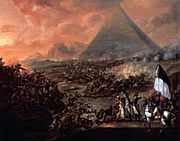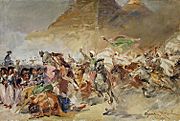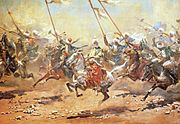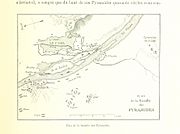Battle of the Pyramids facts for kids
The Battle of the Pyramids, also known as the Battle of Embabeh, was a huge fight that happened on 21 July 1798. It was part of the French invasion of Egypt. The battle took place near the village of Embabeh, which is across the Nile River from Cairo. Napoleon named it after the famous Great Pyramid of Giza, which was visible about 9 miles away.
In this battle, the French army, led by General Napoleon Bonaparte, won a major victory. They defeated the main army of the local Mamluk rulers. This win almost wiped out the Ottoman army in Egypt. It was the first time Napoleon personally used a new battle plan called the divisional square tactic. This tactic worked very well. The French soldiers formed large square shapes, which helped them push back many cavalry charges from the Mamluks.
This victory meant the French had successfully taken over Egypt. Murad Bey, one of the Mamluk leaders, escaped with what was left of his army to Upper Egypt. The French had very few losses, about 300 soldiers killed or hurt. But the Mamluks and Ottoman forces lost thousands. After the battle, Napoleon entered Cairo and set up a new local government. This battle, along with the Battle of the Nile, was part of a bigger fight between France and Britain. France wanted to use Egypt as a base to attack British India. However, the French fleet was later destroyed by Horatio Nelson at the Battle of the Nile.
Quick facts for kids Battle of the Pyramids |
|||||||
|---|---|---|---|---|---|---|---|
| Part of the French Campaign in Egypt and Syria during the War of the Second Coalition | |||||||
 The Battle of the Pyramids by Louis-François Lejeune |
|||||||
|
|||||||
| Belligerents | |||||||
|
|||||||
| Commanders and leaders | |||||||
|
|||||||
| Strength | |||||||
|
20,000–25,000
|
21,000–60,000
|
||||||
| Casualties and losses | |||||||
| 289 killed or wounded | 10,000 killed or wounded | ||||||
Contents
Getting Ready for Battle
After landing in Egypt, which was controlled by the Ottoman Empire, the French army captured Alexandria on 2 July 1798. General Bonaparte then led his army through the desert towards Cairo. They met the Mamluk forces about nine miles (15 kilometres) from the Pyramids. The Mamluk forces were led by two Georgian Mamluks, Murad Bey and Ibrahim Bey. They had a strong force of highly trained cavalry (soldiers on horseback) and also fellahin (peasant) soldiers fighting on foot.
On 13 July, French scouts found Murad's camp. Bonaparte ordered his army to move forward and they had a small fight called the Battle of Chobrakit. The Mamluks retreated after their main ship was destroyed by French cannons. This was a small win for the French.
The Battle Begins
On 21 July, the French army marched all night. They caught up with the Ottoman forces near the village of Embabeh. After a short rest, the soldiers were told to get ready for battle. Bonaparte ordered his army to advance on Murad's army. He arranged each of his five divisions into hollow rectangles, like big squares. The cavalry and supplies were in the middle of these squares, and cannons were at the corners. Bonaparte told his troops to stay strong and keep their lines close together when the Mamluk cavalry attacked.
The French divisions moved south in a staggered line. Their right side was in front, and their left side was protected by the Nile. From right to left, Bonaparte placed the divisions of Louis Charles Antoine Desaix, Jean-Louis-Ébénézer Reynier, Charles-François-Joseph Dugua, Honoré Vial and Louis André Bon. Desaix also sent a small group of soldiers to take over the nearby village of Biktil, to the west.
Murad Bey placed his right side near the Nile at Embabeh village. This village was fortified with soldiers and some old cannons. His left side was at Biktil village, where the rest of his cannons were placed to stop the French from attacking from the side. His Mamluk cavalry was in the middle, between these two villages. The other Mamluk army, led by Ibrahim Bey, was across the Nile. They watched the battle but could not cross the river to help. Murad Bey's plan was to stop the French attacks on his strong sides and then attack their weakened middle.
The Mamluks were a very old-fashioned army, still using medieval ways of fighting. This was very different from the modern French army. Most of the Egyptian army was made up of peasants, but their main strength was the Mamluk horsemen. During the battle, a Mamluk rider, wearing heavy armour, rode very close to the French lines and challenged them to a duel. The French soldiers simply responded by shooting at him.
The Fight and French Victory
Napoleon ordered Desaix's square to move to the right, towards the Mamluk center. The other French squares moved to the left, towards Embabeh. Murad Bey saw this as a chance and ordered his commander, Ayyub Bey, to attack the French squares. Around 3:30 PM, the Mamluk cavalry charged at the French without warning.
However, the French squares, led by Desaix, Reynier, and Dugua, stood strong. They fired their muskets and cannons at close range, pushing back the horsemen. The Mamluks could not break through the French formations. Some frustrated Mamluks rode off to attack Desaix's smaller group, but this also failed.
Meanwhile, closer to the river, Bon's division formed into attack columns and charged Embabeh. The French broke into the village and quickly defeated the soldiers defending it. Many Mamluks and foot soldiers were trapped against the river. They tried to swim to safety, and hundreds drowned.
The French reported very few losses: 29 killed and 260 wounded. Murad's army suffered much heavier losses, perhaps as many as 10,000 soldiers killed or wounded. This included 3,000 of his best Mamluk cavalry. His commander, Ayyub Bey, was also killed. Murad Bey himself was wounded in the cheek. Murad escaped to Upper Egypt with about 3,000 surviving cavalry. He continued to fight a guerrilla war there before being defeated by Desaix in late 1799.
Aftermath of the Battle
When the Mamluk armies in Cairo heard about the defeat of their famous cavalry, they scattered and fled towards Syria. Napoleon entered the captured capital of Egypt on 24 July. On 11 August, French forces caught up with Ibrahim Bey and defeated him badly at Salalieh.
After the Battle of Pyramids, Napoleon set up a French government in Cairo. He put down any rebellions that followed very strictly. Napoleon tried to work with the local Egyptian religious scholars, called ulema. However, scholars like Al-Jabarti did not like the ideas and culture of the French. Even though the French soldiers tried to be friendly to the local people, and some even became Muslim to marry local women, religious leaders still saw the French as very different.
The Battle of the Pyramids marked the beginning of the end for seven centuries of Mamluk rule in Egypt. However, just ten days later, British Admiral Horatio Nelson won a huge victory in the Battle of the Nile. This effectively ended Napoleon's plans in Egypt.
Cultural Depictions
The battle has been shown in art by several artists.
See also
- Military career of Napoleon Bonaparte







